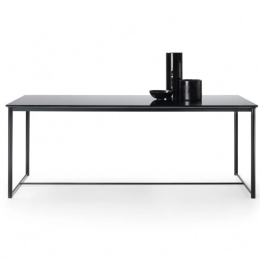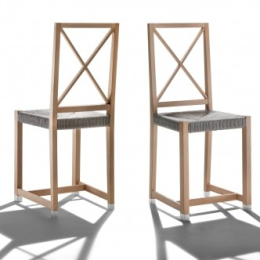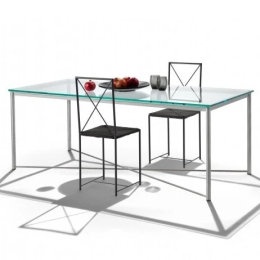Preferences
Mario Asnago, Claudio Vender by Flexform
4 resultsCollection: Mario Asnago, Claudio Vender
Brand: Flexform
Specifications:
Designed in 1939 by Mario Asnago and Claudio Vender, the Moka chair has been part of the Flexform collection since 1985. Mario Asnago and Claudio Vender began their professional partnership in the 1930s and are legitimately considered among the leading exponents of Italian rationalism. Despite its age, the Moka chair is surprisingly modern and dense with design references reminiscent of pure rationalism. The chair’s structure is made of slender, elegant tubular metal and comes in painted black, white or aluminum color. The seat back features an elegant X-shaped design and the unique woven seat is made of plant fiber or cowhide. The pure, uncomplicated design of the Moka chair places it among the products sure to remain untouched by the passage of time and fleeting fashions.
Collection: Mario Asnago, Claudio Vender
Brand: Flexform
Specifications:
Designed in 1939 by Mario Asnago and Claudio Vender, the Moka table has been part of the Flexform collection since 1985. Mario Asnago and Claudio Vender commenced their professional partnership in the 1930s and are legitimately considered among the leading exponents of Italian rationalism. Like its namesake chair, the Moka table is surprisingly modern and dense with design references reminiscent of pure rationalism. The slender, elegant tubular metal table base comes in painted black, white or aluminum color that is thoroughly compatible with the equally understated top, available in wood or glass. The pure, uncomplicated design of the Moka table places it among the products sure to remain untouched by fleeting time and fashions.
Collection: Mario Asnago, Claudio Vender
Brand: Flexform
Specifications:
Designed in 1939 by Mario Asnago and Claudio Vender, the Moka chair has been part of the Flexform collection since 1985, and now comes back in a totally relevant outdoor version. The striking modernity of the original design, dense with design references to the rationalist movement, is now interpreted in innovative materials chosen for their outstanding weather-resistant qualities. The slender, sophisticated structure of the Moka Outdoor chair is made of tubular austenitic stainless steel 316, also available with epoxy powder-coated white, khaki green, wine red or burnished finish. The backrest features an elegant X-design while the seat is made of woven polyester fiber or woven polyurethane rubber in a color palette that ranges from earth tones to bordeaux and olive green. The Moka Outdoor chair also comes in a version with structure in solid iroko with natural finish, or lacquered white or stained grey finish and rests on die-cast metal alloy tips and nylon pads. It is strongly advised that the respective covers be used to keep the Moka Outdoor chairs in top condition and prolong their original beauty as much as possible.
Collection: Mario Asnago, Claudio Vender
Brand: Flexform
Specifications:
In 1985, Flexform decided to include the Moka table and its namesake chair in its collection. The original design dates back to 1939 and is now being introduced in an outdoor version. The uncomplicated yet elegant structure of the Moka Outdoor table is made of tubular austenitic stainless steel 316, also available with epoxy powder-coated white, khaki green, wine red or burnished finish. The top is in transparent tempered glass. It is strongly advised that the respective covers be used to keep the Moka Outdoor tables in top condition and prolong their original beauty as much as possible.
Both Mario and Claudio received Architecture Certification at the Bologna Institute of Fine Arts in 1922. The first joint projects were for competitions, among which the Como War Memorial. In 1928, after obtaining the right to practice as architects, together they opened the Studio Asnago-Vender Architetti. They were mostly involved in town planning architecture. Among the objects designed for interiors were tables and chairs with the characteristic X. The slender structure represents the architectural philosophy of the two designers: surfaces are wide but spaced out with empty spaces that point out the discreet presence of the material, which does not take away lightness, but only part of the stiff evenness that characterizes their interiors. After Asnago's retirement in 1971, Vender continued the business with his son Mario and Mario Moganti.





